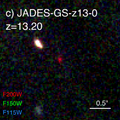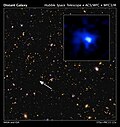
This article lists the most distant astronomical objects discovered and verified so far, and the time periods in which they were so classified.
Contents
- Most distant spectroscopically-confirmed objects
- Candidate most distant objects
- List of most distant objects by type
- Timeline of most distant astronomical object recordholders
- See also
- References
For comparisons with the years after the Big Bang of the astronomical objects listed below, the age of the universe is currently estimated as 13.787 ± 0.020 billion years. [2] However, the estimated age of the universe has increased over the years as the observational techniques have been refined. For the discovery of IOK-1 in 2006 had an estimate of 13.66 billion years for the age of the universe. [3]
Distances to remote objects, other than those in nearby galaxies, are nearly always inferred by measuring the cosmological redshift of their light. By their nature, very distant objects tend to be very faint, and these distance determinations are difficult and subject to errors. An important distinction is whether the distance is determined via spectroscopy or using a photometric redshift technique. The former is generally both more precise and also more reliable, in the sense that photometric redshifts are more prone to being wrong due to confusion with lower redshift sources that may have unusual spectra. For that reason, a spectroscopic redshift is conventionally regarded as being necessary for an object's distance to be considered definitely known, whereas photometrically determined redshifts identify "candidate" very distant sources. Here, this distinction is indicated by a "p" subscript for photometric redshifts. Apart from most commonly used distance measurements for high redshift objects, an alternative is to calculate how old the object is in relation to the Big Bang and the column "Years after the Big Bang" shows these values. [4]







































